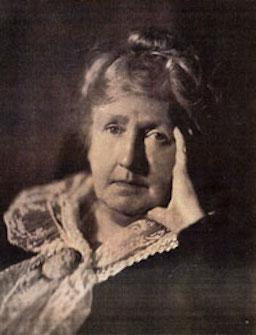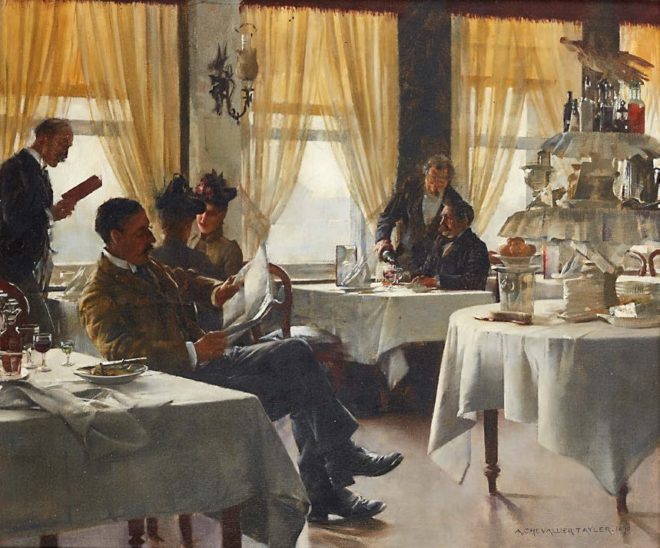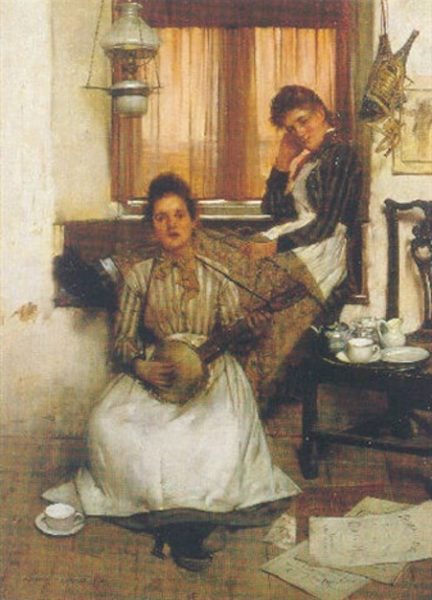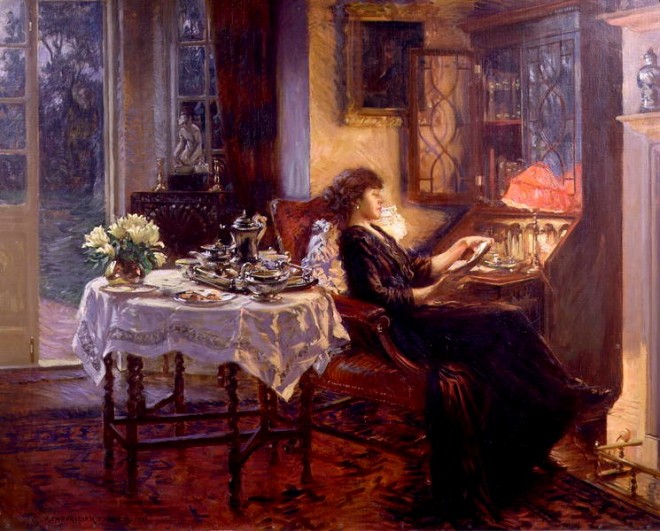 This month’s Waitrose Food Magazine has a feature on ‘the best food writers you’ve never heard of’ and we shall feature all five on the Post this week. First of all our very own Florence White and her ‘magnificent, pioneering classic Good Things in England… A prolific, elegant writer, one of the first freelance food journalists, she wrote: “This book is an attempt to capture the charm of England’s cookery before it is completely crushed out of existence.”‘
This month’s Waitrose Food Magazine has a feature on ‘the best food writers you’ve never heard of’ and we shall feature all five on the Post this week. First of all our very own Florence White and her ‘magnificent, pioneering classic Good Things in England… A prolific, elegant writer, one of the first freelance food journalists, she wrote: “This book is an attempt to capture the charm of England’s cookery before it is completely crushed out of existence.”‘
Archives: Persephone Post
 The Dining Room by Chevallier Tayler, so reminiscent of Tissot, was sold at auction a few years ago and was going to be in the Chris Beetles Summer Show. They write: ‘The artist beautifully captures a sense of light suggestive of a coastal location, perhaps the hotel at which Tayler stayed at Boulogne. That light penetrates semi-transparent curtains, illuminates the whiteness of cloth and napkin and reflects off the polished surfaces of china, glass and metal, the linoleum floor and even the shoes of the most prominent diner.’ Tayler is a great discovery, a neglected artist indeed.
The Dining Room by Chevallier Tayler, so reminiscent of Tissot, was sold at auction a few years ago and was going to be in the Chris Beetles Summer Show. They write: ‘The artist beautifully captures a sense of light suggestive of a coastal location, perhaps the hotel at which Tayler stayed at Boulogne. That light penetrates semi-transparent curtains, illuminates the whiteness of cloth and napkin and reflects off the polished surfaces of china, glass and metal, the linoleum floor and even the shoes of the most prominent diner.’ Tayler is a great discovery, a neglected artist indeed.

This painting, dated 1890, has a rather ridiculous title – A Pretty Melody – but it is very clever in the way it shows that the two young women are obviously listening intently to an unseen musician.
 So who was Albert Chevallier Tayler? (1862-1925)? In his early painting career he was associated with the Newlyn School but then his friend Stanhope Forbes encouraged him to branch out, cf. this description of his painting life on the Bonham’s site when they sold The Letter in 2014
So who was Albert Chevallier Tayler? (1862-1925)? In his early painting career he was associated with the Newlyn School but then his friend Stanhope Forbes encouraged him to branch out, cf. this description of his painting life on the Bonham’s site when they sold The Letter in 2014

So it is the last day of June 2020 and Magento, the ‘shopping platform’ we have used for many years, is dying tonight. Our new website goes live at lunchtime today. It should not look very different. But there will be differences! We shall send an email explaining these to our loyal customers. For now, this is how we wish we were – Quiet Hour 1913 by Albert Chevallier Tayler. But in a few days, when the new website has proved itself, you can be sure that we shall enjoy a quiet hour.

Desperately needed: something period and fun and nothing to do with present-day woes, so on the Post this week the work of Albert Chevallier Tayler. This is A Dress Rehearsal 1888, just look at it and enjoy (as they say in restaurants, when we used to go to restaurants).

And finally the novelist who wrote about Bristol, and Clifton in particular: EH Young. We have often wondered whether she should have another outing (Virago reprinted her, with excellent prefaces by Sally Beauman) but somehow she is faintly underwhelming on re-reading. There will be readers of the Persephone Post who will leap vociferously to her defence. But alas although we admire her, and see her as Bristol’s best novelist, we cannot find enough in any of the novels really, really to engage us. But if you haven’t read her, and especially if you are a Bristolian or simply interested in Bristol, she is a must.

‘In the Library’ St James’s Square, Bristol 1805 by Thomas Pole. We have this exceptionally interesting painting as a poster and sometimes it is in the shop window.

We had the admirable Ellen Sharples on the front of the recent Biannually (which should be arriving about now abroad). Here she is with her daughter Rolinda, and here are the details about their life in Bristol: ‘In 1811 she settled there permanently with her son and daughter and concentrated on establishing a portrait practice. Rolinda’s career took on a different and more ambitious direction, for she began to paint large portraits and complicated group scenes in oils. James, Jr., who lived a more independent life from his mother and sister, continued to paint portraits. The family was successful, but both her children predeceased her. Rolinda died of breast cancer in 1838, and James Jr. died of tuberculosis in 1839. Of her loss, Ellen wrote to a friend,”that in my recent losses, my feelings must have been agonising; for you knew how uniformly exemplary were the affectionate kindness of my dear highly gifted son & daughter to their mother, how devoted she was, placing all her happiness in them….” When Ellen died in 1849 aged 83 she left a substantial estate of £4,000 to the Bristol Academy for the Promotion of Fine Arts which was instrumental in financing Bristol’s first art gallery, now the Royal West of England Academy.’ You can be sure from the intelligence and kindness of their expressions that they would not have approved of the slave trade for one second. And yet remembering how we felt about apartheid in the 1960s and what we could do about it, we cannot censure them for not taking action: many of us now feel consumed with guilt that we did not march every week, write letters every day and generally make our views felt about what was going on in South Africa. While we led our privileged 1960s lives, concerned but absolutely powerless. Cf. the incredible The World that was Ours.
 A House through Time deals compassionately with the fact that 10 Guinea Street, Bristol, was originally built and lived in by families whose wealth was based on the slave trade; obviously the statue of Colston should simply have been removed, placed in a museum, and replaced with a statue of eg. William Wilberforce. The series is excellent and extremely thought-provoking.
A House through Time deals compassionately with the fact that 10 Guinea Street, Bristol, was originally built and lived in by families whose wealth was based on the slave trade; obviously the statue of Colston should simply have been removed, placed in a museum, and replaced with a statue of eg. William Wilberforce. The series is excellent and extremely thought-provoking.